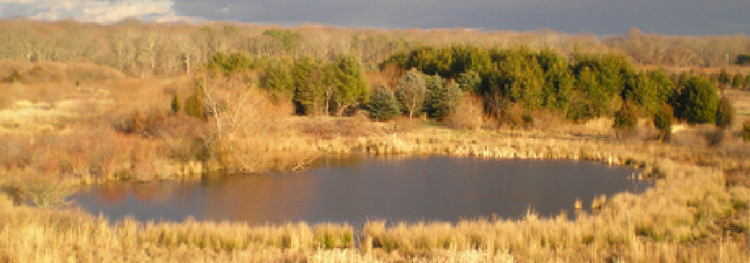Vineyard Fields Ponds
The mixed Vineyard Field habitat, with its scattered ponds, wetlands, and grass meadows fringed by oak forest, hosts a wide array of birds, animals, amphibians, and insects. Some years ago Eric Salzman, an expert birder and musician well known for his proficiency in identifying birds by their songs and calls, led an early June meander through the field and around the ponds. Eric served for many years as a director of the SOFO Museum, which sits at the edge of Vineyard Field. The following account has been adapted from Eric’s field notes.
“This morning’s walk – called Birds of the Meadows and Woods Walk – was focused on the open fields in the back of the SOFO Museum in Bridgehampton. This area, formerly a vineyard and hence known as Vineyard Field, is surrounded by oak woods and is part of the Long Pond Greenbelt that runs from Sagg Pond and Sagg Swamp in Sagaponack all the way north to Sag Harbor. The area contains a chain of coastal plain ponds and wetlands formed during the last glaciation that are fed by groundwater, all surrounded by upland woods. Vineyard Field has been the object of a major effort by the Friends of the Long Pond Greenbelt to restore it as a grassland habitat, including the rooting out of many, but not all, invasive plants.
“As it stands, however, it is not really a grassland but what is traditionally known in these parts as an old field habitat – once open farmland with invading trees. A better term might be ‘savanna,’ the correct term for a meadow or grassland with emergent bushes and trees. Although there’s a tendency to associate savanna with Africa, it’s a real and well-defined habit in many parts of the world, including eastern North America and Long Island. Some of my favorite birds are partial to savanna habitat and, curiously enough, even as woodland and grassland species decline, many savanna species – once common, then later routed by the conversion of savanna to farmland – are now making a striking comeback.
“These were some of the best birds of the morning: indigo bunting (at least three males seen, with two of them singing on widely separate edges of the field), orchard oriole (the name itself suggests its habitat preference), and warbling vireo (a major comeback species and also recognized by song).

“Another feature of this habitat is its popularity with swallows. We saw some barn swallows nesting on the museum buildings, tree swallows on bird boxes scattered about, as well as bank swallows. and a colony of purple martins in the hanging gourd houses installed a few years back. Chimney swifts, a bird with a lifestyle similar to a swallow’s, were also spotted.
“Prominent flycatchers in this habitat are Eastern phoebe and Eastern kingbird (Eastern wood-pewee was in the woodland at the far end of the open meadow). Kingbird, a famously pugnacious flycatcher, was seen first thing in the morning escorting a high-flying but potentially dangerous Cooper’s hawk off the premises. Other raptors were osprey (two or three seen flying across) and red-tailed hawk, who were nesting in the vicinity and heard a number of times, but not actually seen
“And, of course, the more familiar birds of meadow habitat: Northern mockingbird, American robin, red-winged blackbird, and common grackle — all seen in numbers. Cedar waxwings were spotted several times, not in their usual small flocks, but singly and in pairs. They are, no doubt, starting to nest even as other birds are finishing their nesting duties and watching their fledglings take off.
“Not many actual forest birds were seen or heard but those sighted included singing red-eyed vireo, Baltimore orioles with noisy young, and, oddly enough, blue jays in the woods where they are almost certainly nesting. Missing were the more-or-less expected” T-birds”: towhee, thrasher, and thrushes.
